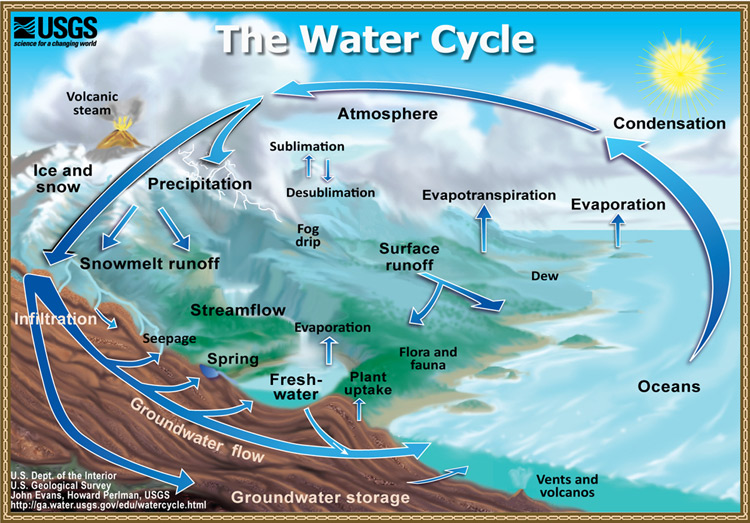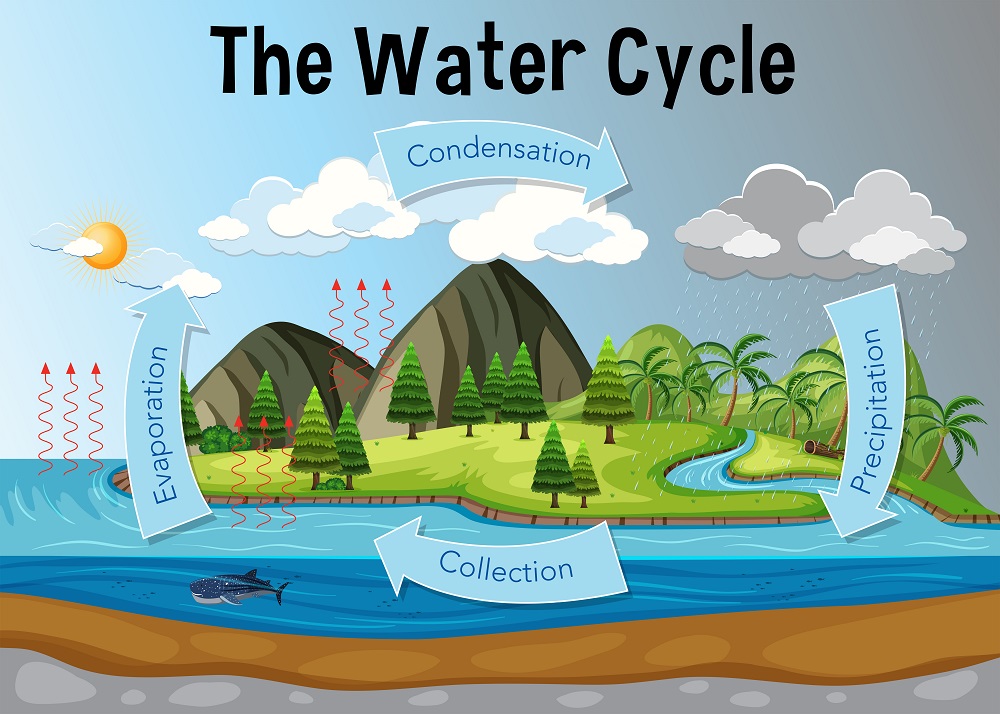What 2 Words Describe the Water Cycle Best
As the word cycle suggests there is no starting pointThat means that we can begin at any point on its journey and follow its path until it gets to where we started again. Students should find that at.
Over time the clouds become heavy because those cooled water particles have turned into water droplets.

. The Water Cycle also known as the hydrologic cycle is the journey water takes as it circulates from the land to the sky and back again. Day three For teachers. In their own words they should describe how the model explains what happens in the water cycle.
Hydroelectric power water use--the use of water in the generation of electricity at plants where the turbine generators are driven by falling water. Next the water vapor cools and forms clouds through condensation. In or to a place that is higher.
Words are listed in alphabetical order. There are 495 water cycle-related words in total with the top 5 most semantically related being water fresh water groundwater precipitation and erosion. The water cycle is defined as a natural process of constantly recycling the water in the atmosphere.
The gas rises and as pressure and temperature decrease with increasing altitude the vapor undergoes condensation to form fog mist and clouds and sublimation into ice crystals. It is also known as the hydrological cycle or the hydrologic cycle. Weather is the state of the atmosphere describing for example the degree.
Solar energy causes evaporation from bodies of water and plants as well as sublimation of ice. During this process water changes its state from one phase to another but the total number of water particles remains the same. You can get the definitions of a word in the list below by tapping the question-mark icon next to it.
Water molecules are heated by the sun and turn into water vapor that rises into the air through a process called evaporation. The words at the top of the list are the ones most associated with water cycle and as you go down the relatedness becomes. As the water vapor rises higher and higher the cool air of the atmosphere causes the water vapor to turn back into liquid water creating clouds.
The water cycle is simply the complete journey that water makes in its life from one place to another and from one state to the other. Warm water vapor rises up through Earths atmosphere. THE CHANGES PHASES OF THE WATER CYCLE.
When the clouds become extremely heavy with water droplets the. The water cycle is a process where first the water moves from one reservoir to another like from a river to the sea and then to the ocean. Eg of CONDENSATIONIf the kettle was one and you hold a plate on top of the kettle the plate will get all swetty.
A spell of good weather. In the solid form it is popularly known as ice. In liquid form it is popularly known as water.
The solid liquid and gaseous form. Rivers are part of. Describe the water cycle.
Cloudy overcast cloudless clear bright blue gray BrE grey dark. But most of the water flows downhill as runoff above ground or underground eventually returning to the seas as slightly salty water. A good way to assess their understanding is to have them write a story from the point of view of a water molecule as it travels through the water cycle.
The paths and influences of water through Earths ecosystems are extremely complex and not completely understood. Ask them to be as detailed as. During the process of the water cycle between the earth and the atmosphere water changes into three states of matter solid liquid and gas.
The water cycle is self-renewing and non-stop. A water cycle is like evaporation or the opposite which is condensation. The water cycle also known as the hydrologic cycle is the process by which water moves from place to place above on and below the Earths surface.
Hydrologic cycle--the cyclic transfer of water vapor from the Earths surface via evapotranspiration into the atmosphere from the atmosphere via precipitation back to earth and through runoff into streams rivers and. Precipitation falls to the surface in the form of rain snow etc. The water falling on land collects in rivers and lakes soil and porous layers of rock and much of it flows back into the oceans where it.
A patch of blue sky. To begin with water gets evaporated from the water. How can we describe weather.
The water cycle is often taught as a simple circular cycle of evaporation condensation and precipitation. A two-day spell of sunny weather. The water cycle describes how water evaporates from the surface of the earth rises into the atmosphere cools and condenses into rain or snow in clouds and falls again to the surface as precipitation.
The water cycle causes the water to change its form from one to another naturally. Water is the only substance that exists on Earth in every one of its 3 states and easily modifications from one nation to another. A Journey Through the Water Cycle Each student should be able to describe the water cycle either orally written or visually using the vocabulary above.
Earths water is always in movement and is always changing states from liquid to vapor to ice and back again. Rainy wet humid dry arid frigid foggy windy stormy breezy windless calm still. Water sometimes modifications its place by converting nation in a non-stop sample called the water cycle or the hydrologic cycle.
I think there are only 3 words in the water cycle1 evaporation2 condensation3 precipitation. The water cycle also known as the hydrologic cycle or the hydrological cycle describes the continuous movement of water on above and below the surface of the Earth. The entire process of water cycle takes place in almost five steps which includes the evaporation condensation precipitation infiltration and runoff.
It is called a cycle because water continuously moves around the system. Although this can be a useful model the reality is much more complicated. A spell of rainy weather.
Water is always changing states between liquid vapor and ice with these processes happening in the blink of an eye and over millions of years. The water cycle is also known as the hydrological cycle. The water cycle describes the existence and movement of water on in and above the Earth.
Earths water is always in movement and the natural water cycle also known as the hydrologic cycle describes the continuous movement of water on above and below the surface of the Earth. And in gaseous form it is popularly known as water vapor or just vapor. Asaliquidgasorsolid poweredbythesunandthe forceofgravitywatertravels overunderandabovethesur- faceoftheEarthinanincredible journeycalledthewatercycle.
This is called transpiration.

Water Cycle The Definitive Guide Biology Dictionary


Comments
Post a Comment